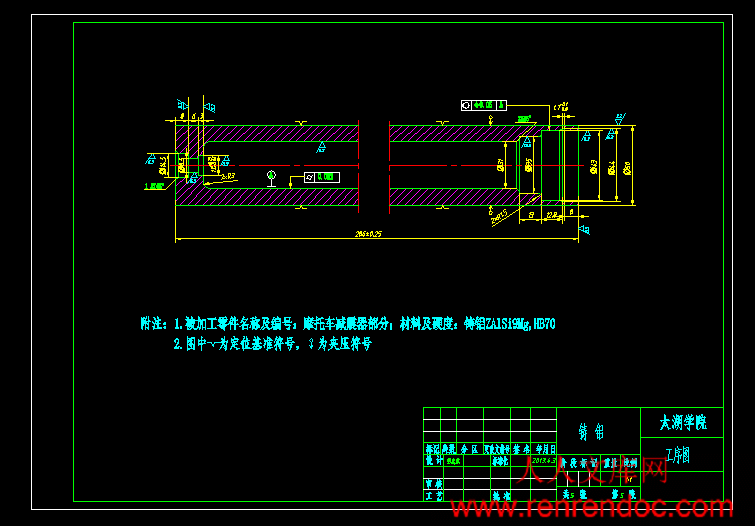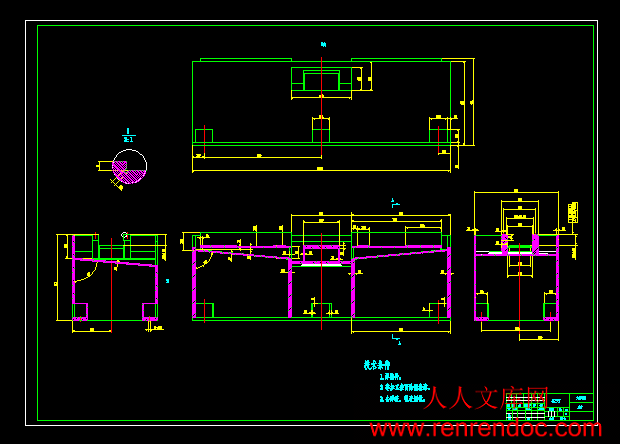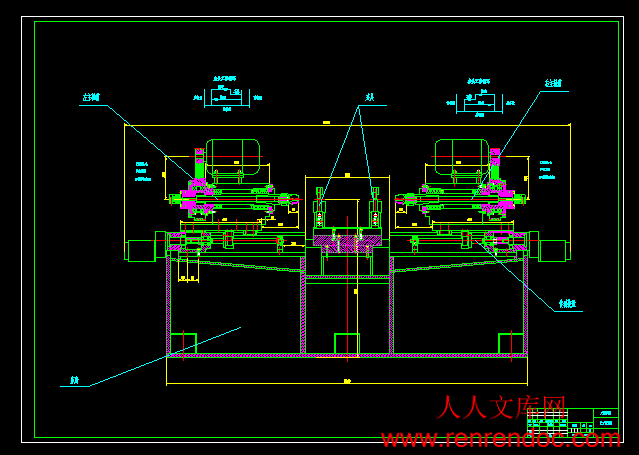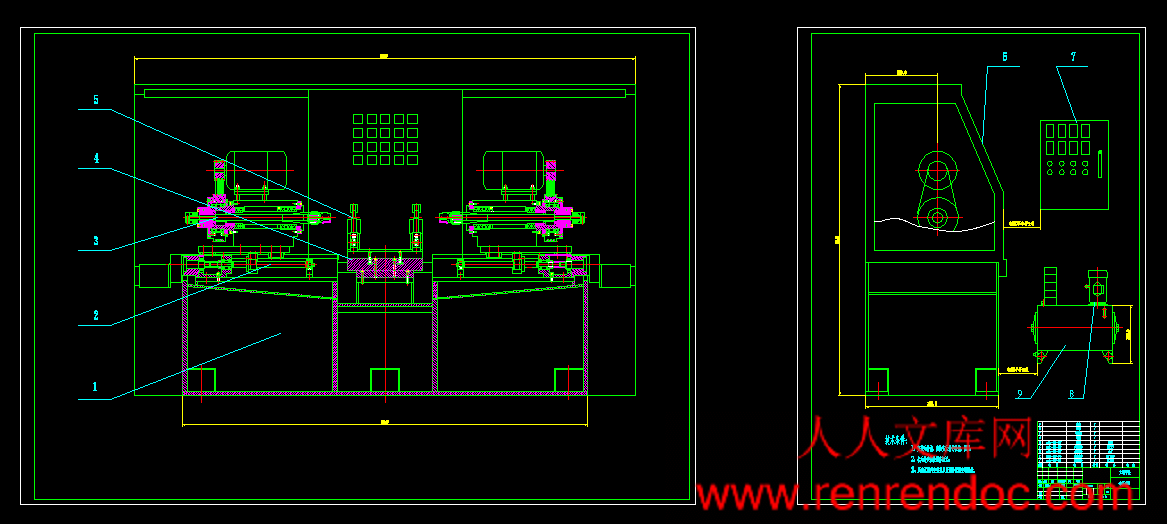双头钻扩铰专机设计-专机总体及主轴箱设计
51页 31000字数+说明书+任务书+开题报告+8张CAD图纸【详情如下】
专机总体图2张.dwg
主轴箱装配图.dwg
任务书.doc
加工示意图.dwg
双头钻扩铰专机设计-专机总体及主轴箱设计开题报告.doc
双头钻扩铰专机设计-专机总体及主轴箱设计论文.doc
外文翻译--基本加工工序和切削技术.doc
尺寸联系图.dwg
工序图.dwg
床身.dwg
生产率计算卡.dwg
相关资料.doc
计划周记进度检查表.xls
摘 要
组合机床是一种高效专用机床,有特定的使用条件。在确定设计机床前,应该进行具体的经济技术分析。加工同一个机械产品的零件,通常会有很多种工艺方案,不同的方案会有不同的经济效果,影响技术经济的因素有很多,有时技术指标先进的方案,经济指标不一定优越。因此,需要对技术、经济指标作综合评价,选出优化方案进行经济效果评价,如果满意即可决定。
本课题是双头钻扩铰专机设计。其来源于惠发特精密机械有限公司。在设计中,通过研究被加工零件的特点,对相关数据进行计算,对相关部件进行选择,从而确定机床的总体布局。并绘制出被加工零件工序图,加工示意图,机床联系尺寸图和生产率计算卡。在此基础上拟定了主轴箱的传动路线,设计了轴的结构,进行了皮带轮及轴等相关零件的强度,刚度校核,并绘制出主轴箱装配图。该机床对零件的两端孔同时进行加工,加工的工艺性好,工件装夹方便。采用滚珠丝杠导轨实现刀具进给。工件采用V形块定位,液压夹紧,一次装夹完成不仅保证了孔的加工精度,而且还提高了加工效率,降低了工人的劳动强度。
关键词:双头钻扩铰专机;组合机床;主轴箱
目 录
摘 要III
AbstractIV
目 录V
1 绪 论1
1.1 惠发特精密机械有限公司简介1
1.2 本设计任务简介1
1.3本设计应达到的要求1
2 机床总体设计2
2.1 工艺方案制定2
2.1.1 工件和加工部位的主要要求2
2.1.2 拟定工艺路线2
2.1.3 二种工艺线路的比较与确定及其各分析其优缺点6
2.1.4 安装与夹紧方案的比较与确定,包括定位、夹紧、夹紧部位、形式等7
2.1.5 刀具、辅具的确定8
2.1.6 工序8
2.1.7 工序的集中与分散9
2.1.8 确定加工工艺路线9
2.1.9 加工工序卡片10
2.2 专机总体设计11
2.2.1 确定专机的驱动方式,切削力,切削功率、电动机选择等计算13
2.2.2 基本参数(尺寸)设计17
2.2.3 传动系统设计17
2.2.4三图一卡的设计19
3 主轴箱的设计27
3.1 主轴箱及其卸荷机构27
3.2 主轴的结构型式28
3.2.1 主轴的构造28
3.3 主轴的轴承选用29
3.3.1 几种轴承的比较29
3.3.2 轴承的安装与定位30
3.4 主轴刚度计算30
3.5 轴承寿命计算31
3.6 电机的安装33
3.7 两主轴箱等高与共线调节33
4 其他设计34
4.1 夹具34
4.2 进给系统34
4.3 液压原理34
4.4 冷却系统35
5 附件设计部分(床身部件)36
5.1 对床身部件的具体要求36
5.2 选择床身部件的材料、毛胚制造方式36
5.2.1 铸造加工工艺36
5.2.2 焊接加工工艺36
5.3 对床身部件与其他部件联系的方式确定36
5.3.1 床身与其余部件的整体布局36
5.3.2 导轨安装36
5.3.3 排屑及冷却液回流37
5.3.4 起吊问题37
5.4 床身部件加工工艺方案及工艺路线确定37
5.4.1 加工工艺方案的比较与确定37
5.4.2 加工工艺路线39
5.5 技术要求说明39
6 结论与展望41
致谢42
参考文献43
1 绪 论
1.1 惠发特精密机械有限公司简介
无锡惠发特精密机械有限公司位于无锡市惠山区堰桥镇工业园,公司生产工艺先进,设备齐全,技术力量雄厚。专门从事各种系列型号液压机的生产,其各项性能指标均已达到国外同类产品的水平。
公司全体员工秉承“追求卓越品质,满足客户需求”的经营理念,不断强化质量管理,坚持跟踪服务,已通过了ISO9001:2000国际质量体系认证,为各种内燃机、电机电器、汽车、摩托车、粉末冶金、轴承等良好组配创造了条件。同时还生产专用组合机床、数控专用组合机床及三棍轮、二棍轮精密校直机。
1.2 本设计任务简介
本设计是从事专业机床设计,包括总体设计、进给系统、床身部件、液压系统、主轴箱设计。
课题来源于无锡市惠发特精密机械有限公司。本课题系机动车减震器缸筒加工的专用机床设计,对于摩托车及其这一类机动车的减震器缸筒加工均有一定得参考价值,在减震器行业技术更新中起相当的作用。
此次毕业设计任务要求机床功能得到进一步的完善,能够提高零件的加工精度和加工效率,能够降低加工成本。该零件属摩托车减震器用,其材料为铸铝,要求单班制生产,年产量5万件。限于水平和经验,不完善之处,敬请批评指正。
1.3本设计应达到的要求
1. 对缸体加工工艺(经简化)方案的简要分析比较。
2. 完成本工序的工序图,加工示意图,机床总图及床身部件图。
3. 设计说明书一份,要求对机床的总体设计部分详细分析说明,并包括必要的计算,文字简洁通顺,重要公式数据应注明出处。
4. 对制造厂家调研,了解其对质量、成本要求,所设计的专机要结合厂方具体生产条件。2 机床总体设计
2.1 工艺方案制定
机械加工工艺规程是规定产品或零部件机械加工工艺过程和操作方法的工艺文件。生产规模的大小,工艺水平的高低以及解决各种工艺问题的方法和手段都要通过机械加工工艺规程来体现。因此,机械加工工艺规程设计是一项重要而又严肃的工作。为能具体确切地说明工艺过程,一般将机械加工工艺过程分为工序、安装、工位、工步、走刀。
工艺方案制定正确与否,将决定机床能否达到“体积小,重量轻,结构简单,使用方便,效率高,质量好”的要求,这是设计最重要的一步。
为使工艺方案制定的合理、先进,必须认真分析被加工的零件图纸,深入现场全面了解被加工零件的结构特点,加工部位,尺寸精度,表面粗糙度和技术要求,定位夹紧方式工艺方法和加工过程所采用的刀具,辅具,切屑用量。分析其优缺点,总结设计,制造,使用单位和操作者的丰富的实践经验,以求理论紧密联系实际,从而确定零件在组合机床上完整的工艺(工序)内容及方法,从而决定刀具种类,结构型式,数量及切屑用量等。
根据选定的工艺方案确定机床的配置形式,并制定出影响机床总体布局和技术性能的主要部件结构方案。既要考虑能实现工艺方案,以确保零件的加工精度,技术要求及生产率;又要考虑机床的操作方便可靠,易于维修,且冷却,排屑情况良好。
对于同一个零件的加工,可能会有各种不同的工艺方案和机床配置方案,在最后决定采取哪种方案时,决不能草率,要全面地看问题,综合分析各方面的情况,进行多种对比,选择最佳方案。
2.1.1 工件和加工部位的主要要求
被加工零件为棒状铝合金:
牌号: 代号:ZL104 铸造方法 :金属型
热处理: 淬火+人工时效
力学性能:抗拉强度/:145 伸长率δ5(%):2
布氏硬度HBS(5/250/30):70
铸铝合金应具有良好的铸造性能,其成分应接近共晶点。
双孔加工:左端 Ф14.5,表面粗糙度Ra=6.3微米
右端阶梯孔 最大Ф43,最小Ф35,表面粗糙度Ra=6.3微米
其他技术要求见零件图,要求年产量为5万件,单班制生产。实物图如图2.1。





 川公网安备: 51019002004831号
川公网安备: 51019002004831号